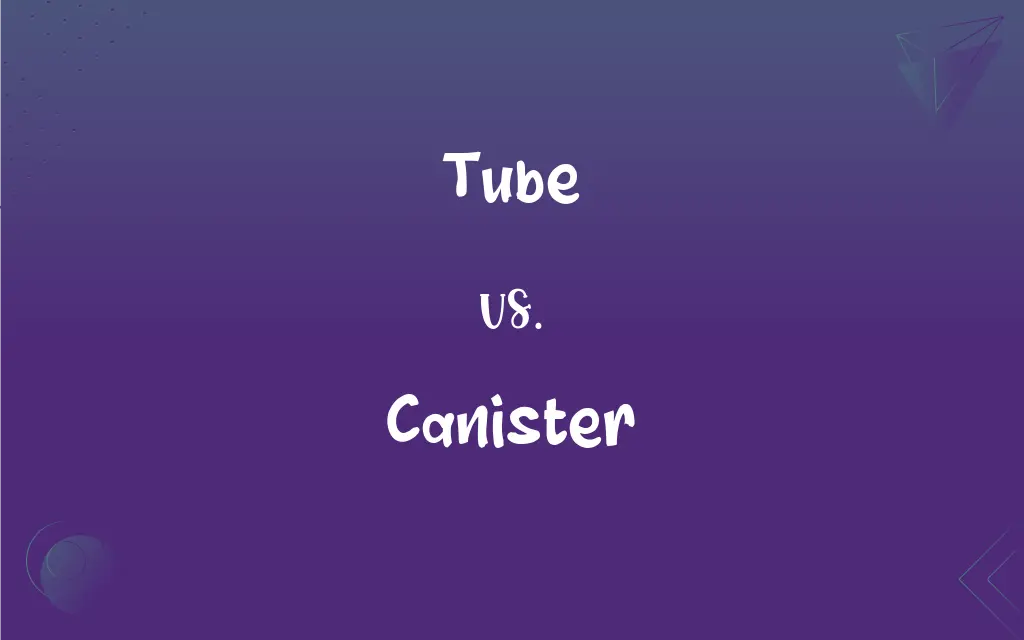Tube vs. Canister: What's the Difference?
Edited by Aimie Carlson || By Janet White || Updated on October 7, 2023
A tube is a hollow cylindrical container, often flexible, whereas a canister is a rigid container with a lid, typically used for storing dry goods.

Key Differences
A tube and a canister are both containers, but they differ in structure, material, and use. A tube is generally a long, cylindrical, and often flexible container, usually used to hold and dispense liquids or semi-liquids like toothpaste or ointment. In contrast, a canister is typically a rigid, boxlike or cylindrical container with a lid, often used for storing dry goods like tea, coffee, or sugar.
Tube, due to its flexibility and squeezability, is predominantly used for packaging that requires precise application, such as in the cases of adhesive or cosmetic products. The structure of a tube makes it an ideal container for products that are to be expelled by applying pressure. Canister, with its rigidity and sealing capability, is particularly suitable for storing products that need protection from air and moisture, ensuring that the contents remain fresh and uncontaminated.
The materials used for tubes and canisters also vary. Tubes are often made from plastic, metal, or glass and are usually sealed with a cap. They can be transparent or opaque, allowing or preventing the visibility of the content inside. Canisters, on the other hand, can be made from plastic, metal, glass, or even ceramic, and they come with a removable or hinged lid, often equipped with a sealing mechanism to preserve the freshness of the content inside.
In essence, while both tubes and canisters serve the purpose of containing and preserving items, their distinct characteristics make them suitable for different kinds of products. The elongated, cylindrical shape and flexibility of tubes make them an ideal choice for dispensing liquids or creams, while the sturdy structure and sealable lid of canisters make them perfect for storing solid or dry items.
Comparison Chart
Structure
Cylindrical, often flexible.
Rigid, cylindrical or boxlike.
ADVERTISEMENT
Typical Use
Holding and dispensing liquids or semi-liquids.
Storing dry goods.
Material
Usually made of plastic, metal, or glass.
Can be made of plastic, metal, glass, ceramic
Closure
Sealed with a cap.
Comes with a removable or hinged lid.
Visibility
Can be transparent or opaque.
Varies, depending on material and design.
Tube and Canister Definitions
Tube
A conduit made from metal, plastic, or other material.
The scientist used a glass tube for the experiment.
ADVERTISEMENT
Canister
A cylindrical container for holding a gas under pressure.
The canister of propane was attached to the grill.
Tube
A vehicle or device operating in a tunnel-like structure.
We took the tube to travel across the city quickly.
Canister
A small, rigid container with a lid for storing goods.
I stored the freshly ground coffee in an airtight canister.
Tube
A hollow cylinder, especially one that conveys a fluid or functions as a passage.
Canister
A metallic container holding film or other sensitive material.
The photographer placed the film in a lightproof canister.
Tube
An organic structure having the shape or function of a tube; a duct
A bronchial tube.
Canister
A container with perforations for sprinkling contents.
I used a canister to sprinkle powdered sugar on the dessert.
Tube
A small flexible cylindrical container sealed at one end and having a screw cap at the other, for pigments, toothpaste, or other pastelike substances.
Canister
A military container for dispensing substances like smoke or gas.
The soldier threw a smoke canister to provide cover.
Tube
(Music) The cylindrical part of a wind instrument.
Canister
A box or can of thin metal or plastic used for holding dry foodstuffs or cooking ingredients, such as flour or sugar.
Tube
An electron tube.
Canister
A small plastic container used for storing a roll of film.
Tube
A vacuum tube.
Canister
A metal container that holds pressurized gas, as one containing tear gas that explodes on impact or one containing oxygen as part of a breathing apparatus.
Tube
(Botany) The lower, cylindrical part of a gamopetalous corolla or a gamosepalous calyx.
Canister
A metallic cylinder packed with shot that scatter upon discharge from a cannon, formerly used as an antipersonnel round.
Tube
A tunnel.
Canister
Such cylinders, or the shot used in such cylinders, considered as a group.
Tube
An underground railroad system, especially the one in London, England.
Canister
The part of a gas mask that contains the filter for removing toxic agents from the air.
Tube
The elongated space inside a wave when it is breaking.
Canister
A cylindrical or rectangular container usually of lightweight metal, plastic, or laminated pasteboard used for holding a dry product (as tea, crackers, flour, matches).
Tube
An inner tube.
Canister
Any of various cylindrical metal receptacles usually with a removable close-fitting top.
Tube
An inflatable tube or cushion made of rubber or plastic and used for recreational riding, as behind a motor boat or down a snow-covered slope.
Canister
A special short-range antipersonnel projectile consisting of a casing of light metal, loaded with preformed submissiles such as flechettes or steel balls. The casing is designed to open just beyond the muzzle of the weapon, dispersing the submissiles.
Tube
Television
What's on the tube?.
Canister
A projectile component containing colored or screening smoke or riot control agent composition.
Tube
A television set.
Canister
A component of canister-type protective masks containing a mechanical filter and chemical filling to filter, neutralize and/or absorb toxic chemical, biological and radiological agents.
Tube
Tubes(Informal) The fallopian tubes.
Canister
Part of a windmill that connects the sails to the windshaft.
Tube
To provide with a tube; insert a tube in.
Canister
(transitive) To pack into a canister.
Tube
To place in or enclose in a tube.
Canister
A small basket of rushes, reeds, or willow twigs, etc.
Tube
To ride or float on an inflated tube for recreation.
Canister
A small box or case for holding tea, coffee, etc.
Tube
Anything that is hollow and cylindrical in shape.
Canister
A kind of case shot for cannon, in which a number of lead or iron balls in layers are inclosed in a case fitting the gun; - called also canister shot.
Tube
An approximately cylindrical container, usually with a crimped end and a screw top, used to contain and dispense semiliquid substances.
A tube of toothpaste.
Canister
A metallic cylinder packed with shot and used as ammunition in a firearm
Tube
The London Underground railway system, originally referred to the lower level lines that ran in tubular tunnels as opposed to the higher ones which ran in rectangular section tunnels. (Often the tube.)
I took the tube to Waterloo and walked the rest of the way.
Canister
Metal container for storing dry foods such as tea or flour
Tube
(obsolete) One of the tubular tunnels of the London Underground.
Tube
A tin can containing beer.
Tube
(surfing) A wave which pitches forward when breaking, creating a hollow space inside.
Tube
A television. Compare cathode ray tube and picture tube.
Tube
An idiot.
Tube
(transitive) To supply with, or enclose in, a tube.
She tubes lipstick in the cosmetics factory.
Tube
To ride an inner tube.
They tubed down the Colorado River.
Tube
To intubate.
The patient was tubed.
Tube
A hollow cylinder, of any material, used for the conveyance of fluids, and for various other purposes; a pipe.
Tube
A telescope.
Tube
A vessel in animal bodies or plants, which conveys a fluid or other substance.
Tube
The narrow, hollow part of a gamopetalous corolla.
Tube
A priming tube, or friction primer. See under Priming, and Friction.
Tube
A small pipe forming part of the boiler, containing water and surrounded by flame or hot gases, or else surrounded by water and forming a flue for the gases to pass through.
Tube
A more or less cylindrical, and often spiral, case secreted or constructed by many annelids, crustaceans, insects, and other animals, for protection or concealment. See Illust. of Tubeworm.
Tube
A tunnel for a tube railway; also (Colloq.), a tube railway; a subway.
Tube
To furnish with a tube; as, to tube a well.
Tube
Conduit consisting of a long hollow object (usually cylindrical) used to hold and conduct objects or liquids or gases
Tube
Electronic device consisting of a system of electrodes arranged in an evacuated glass or metal envelope
Tube
A hollow cylindrical shape
Tube
(anatomy) any hollow cylindrical body structure
Tube
Electric underground railway
Tube
Provide with a tube or insert a tube into
Tube
Convey in a tube;
Inside Paris, they used to tube mail
Tube
Ride or float on an inflated tube;
We tubed down the river on a hot summer day
Tube
Place or enclose in a tube
Tube
A hollow, cylindrical container, often flexible.
I squeezed the tube to get the last bit of toothpaste out.
Tube
A tunnel-like structure providing a path.
The mice ran through a tube in the maze.
Tube
A tubular shape or form.
The roll of paper formed a sturdy tube.
FAQs
Are canisters suitable for storing liquids?
Generally, canisters are used for dry goods, but some sealable canisters can store liquids.
Is a tube always flexible?
While many tubes are flexible, some, especially those made of glass or metal, are rigid.
Are tubes recyclable?
Many tubes, especially those made of plastic or metal, are recyclable.
Can canisters be decorative?
Yes, canisters, especially those made of ceramic or glass, can be decorative.
Can a tube be sealed permanently?
Yes, some tubes are sealed permanently, especially those used in laboratories.
Can a canister be transparent?
Yes, canisters can be transparent, especially those made of glass or clear plastic.
Can a canister have a screw-on lid?
Yes, many canisters have screw-on lids to ensure a tight seal.
Are canisters airtight?
Many canisters are designed to be airtight to preserve the contents.
Are tubes only used for holding liquids?
While commonly used for liquids, tubes can also hold semi-solids and gases.
Are all tubes transparent?
No, tubes can be transparent, translucent, or opaque.
Can canisters have a handle?
Some canisters come with handles for easy carrying and usage.
Can tubes be reusable?
Some tubes are designed to be reusable, while others are disposable.
Do tubes come in different shapes?
Tubes are typically cylindrical, but they can vary in length and diameter.
Are canisters used in the military?
Yes, canisters are used in the military to hold and disperse substances like gas.
Can a tube have a pump dispenser?
Yes, some tubes come with pump dispensers for controlled dispensing of the content.
About Author
Written by
Janet WhiteJanet White has been an esteemed writer and blogger for Difference Wiki. Holding a Master's degree in Science and Medical Journalism from the prestigious Boston University, she has consistently demonstrated her expertise and passion for her field. When she's not immersed in her work, Janet relishes her time exercising, delving into a good book, and cherishing moments with friends and family.
Edited by
Aimie CarlsonAimie Carlson, holding a master's degree in English literature, is a fervent English language enthusiast. She lends her writing talents to Difference Wiki, a prominent website that specializes in comparisons, offering readers insightful analyses that both captivate and inform.































































